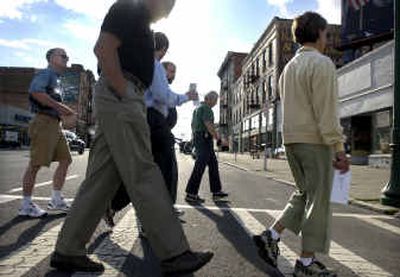Shaping a University District

People taking a University District walking tour Saturday caught a glimpse of the other side of the tracks and discovered that the view is phenomenal.
The tour segued into a University District community planning meeting that brought together 80 residents who bypassed a chance to bask in the sun to sit inside Gonzaga University’s COG and brainstorm ideas for creating a viable college community.
The city of Spokane and a group of partners are working to create a University District at Riverpoint, on Trent Avenue adjacent to Gonzaga University. The proposed district is starting to develop and could eventually have up to 14 buildings that integrate the city’s health-care industry with technology and programs offered through Eastern Washington University, Washington State University, the Community Colleges of Spokane and Spokane Intercollegiate Research and Technology Institute.
The project’s goal is to spur community renovation and economic development throughout the region. Urban planners and project supporters are holding guided walking tours and community meetings to generate ideas on how to build a dynamic urban core with the infrastructure, housing and services to accommodate large numbers of students.
A half-dozen early risers took the 7:30 a.m. walking tour and strolled from Main Avenue to Sherman Street to view land that may someday form key connecting points to the campus conglomerate along Trent.
Wedged between boxy commercial buildings and semitrucks, on Sprague Avenue and Grant Street, were previously unappreciated pockets of land that offered stunning city views and the potential to become small city parks.
“It’s so interesting that it can encompass this certain area that’s often forgotten by everyone,” said Christie Hinnen. “It’s really exciting. I’d like to see it happen now instead of in 2010 or 2020.”
She and her husband, Mike, sold their South Hill home and moved to the downtown area. They support the project, which they believe will spur economic development and enhance the beauty of the community.
Charming historic buildings popped up among commercial properties near Pacific Avenue and Pine Street, giving participants hope that with the right combination of preservation, renovation, new construction and landscaping, the area could become a trendy college metropolis.
Walkers learned about ideas to improve traffic flow and make the area pedestrian-friendly by integrating trails and building bridges over the railroad tracks so students could walk or ride bikes to school. Mixed-use buildings could provide shops, offices and apartments and small businesses could sell students everything from lattes to organic produce.
Interestingly, clusters of shops at Pacific Avenue and Sherman Street, Division Street and Main Avenue, and along Hamilton already sell many of the goods and services that college students want.
“What’s really unique to me is all the businesses that you would really want in a university district are already here,” said Dick Winchell, an Eastern Washington University urban regional planning instructor who led the tour. Businesses that offer complementary services can easily locate in those areas and add their services to the mix.
Later in the morning, the community meeting highlighted plans for the district, which include up to 14 buildings in one integrated college campus. The workshop was the second in a series of four meetings, which are designed to gather ideas and generate community support.
Participants worked in small groups and visited five different stations where presenters used maps and illustrations and shared ideas about transportation, neighborhood aesthetics and even environmental preservation. Ideas ranged from planting rooftop gardens to offering free trolley service and enlisting the help of volunteer cleanup crews.
Mindy Stewart, the wife of a WSU professor and a mother who provides day-care services for corporations, pointed out the importance of incorporating ample quality day care for faculty and students.
Also, without convenient parking, Stewart believes many families might not stop and shop at local businesses. “Myself, with two small children, if there wasn’t somewhere nearby to park, I wouldn’t do it.”
Within two years, the Intercollegiate College of Nursing/Washington State College of Nursing will locate on the campus, and researchers are trying to determine the needs of the combined student population, which range from housing to parking, groceries and other services.
Plans incorporated routes for the proposed light rail system and examined the possibility of offering trolley service, which one participant suggested should be free to encourage use.
Robin Toth, economic development manager for the city of Spokane, said Saturday’s meeting attracted a wide range of community activists, politicians, professors and businesspeople.
Toth said people have listed a variety of reasons for supporting the project, including its ability to create jobs and the opportunity to design the University District to showcase the Spokane River. “This is a project that everyone can embrace.”